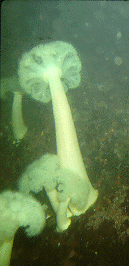Biomechanics of hydrostatic skeletons

Many animals and plants change shape and generate forces by inflating cylindrical fiber-wound structures either by muscular action or by osmotic swelling. We have studied the mechanical design of various hydrostatically-supported organisms, such as sea anemones and soft corals, have analyzed the microarchitecture and mechanical properties of the biomaterials from which they are built, and have assessed their mechanical performance in the field. We have also investigated the biomechanics of the hydrostatic notochords that straighten and elongate early frog embryos. We have used physical models of hydraulic cylinders to investigate the consequences of different arrangements of the reinforcing fibers to the flexural stiffness, shape changes, and force production performance of hydraulic skeletons. We have also studied the mechanics and scaling of worm burrowing.
Selected references on this topic
- Koehl, M. A. R. (1977) Mechanical diversity of the connective tissue of the body wall of sea anemones. J. Exp. Biol. 69: 107-125.
- Koehl, M. A. R. (1982) Mechanical design of spicule-reinforced connective tissues: Stiffness. J. Exp. Biol. 98: 239-268.
- Hanken, J. and M. A. R. Koehl (1984) Technique for visualizing the three-dimensional architecture of spiculated animals. Stain Technol. 59: 65-69.
- Koehl, M. A. R., D. S. Adams, and R. E. Keller (1990) Mechancial development of the notochord in early tail-bud amphibian embryos. pp. 471-485. In, N. Akkas [ed.], Biomechanics of Active Movement and Deformation of Cells. Springer-Verlag.
- Adams, D. S., R. E. Keller, and M. A. R. Koehl (1990) Mechanism of straightening and elongation of the notochord of Xenopus laevis. Development. 110: 115-130.
- Quillin, K.J. (1998) Ontogenetic scaling of hydrostatic skeletons: Geometric, static stress and dynamic stress scaling of the earthworm, Lumbricus terrestris. J. Exp. Biol. 201: 1871-1883.
- Quillin, K.J. (1999) Kinematic scaling of locomotion by hydrostatic animals: Ontogenetic peristaltic crawling by the earthworm Lumbricus terrestris. J. Exp. Biol. 202: 661-674.
- Quillin, K.J. (2000) Ontogenetic scaling of burrowing forces in the earthworm Lumbricus terrestris. J. Exp. Biol. 203: 2757-2770.
- Koehl, M.A.R., K.J. Quillin, and C. Pell. (2000) Mechanical design of fiber-wound hydraulic skeletons: The stiffening and straightening of embryonic notochords. Am. Zool. 40: 28-41.
- Koehl, M. A. R. (2003) Physical modelling in biomechanics. Phil Trans. Roy. Soc. Lond. B. 358: 1589-1596.
- Wolgemuth, C. W., Y. Inclan, J. Quan, G. Oster and M. A. R. Koehl (2005) How to make a spiral bacterium. Physical Biology 2: 189-199.
- Dorgan, K.M. (2010) Environmental constraints on the mechanics of crawling and burrowing using hydrostatic skeletons. J. Exp. Mech., special issue on locomotion. DOI: 10.1007/s11340-010-9399-2
- Che, J. and K.M. Dorgan. (2010) It's tough to be small: Dependence of burrowing kinematics on body size. J. Exp. Biol. 213: 1241-1250.
- Che, J., K.M. Dorgan. (2010) Mechanics and kinematics of backward burrowing by the polychaete, Cirriformia moorei. J. Exp. Biol. 213: 4272-4277.
- Murphy, E.A.K. and K.M. Dorgan. (2011) Burrow extension with a proboscis: Mechanics of burrowing by the glycerid, Hemipodus simplex. J. Exp. Biol. 214: 1017-1027.
- Dorgan, K.M., S. Lefebvre, J.H. Stillman, M.A.R. Koehl. 2011. Energetics of burrowing by the cirratulid polychaete, Cirriformia moorei. Journal of Experimental Biology 214: 2202-2214.
Links to Specific Topics
- Fluid dynamics of hairy little legs
- Microscopic organisms swimming in turbulent flow/Larval Settlement
- Fluid dynamics of odor capture by olfactory antennae
- Selective factors in the evolution of multi-cellularity
- How do benthic organisms withstand and utilize moving water?
- Biomechanics of morphogenesis
- Evolution of novel function / Consequences of body size
- Fluid dynamics of animals at intermediate Re
